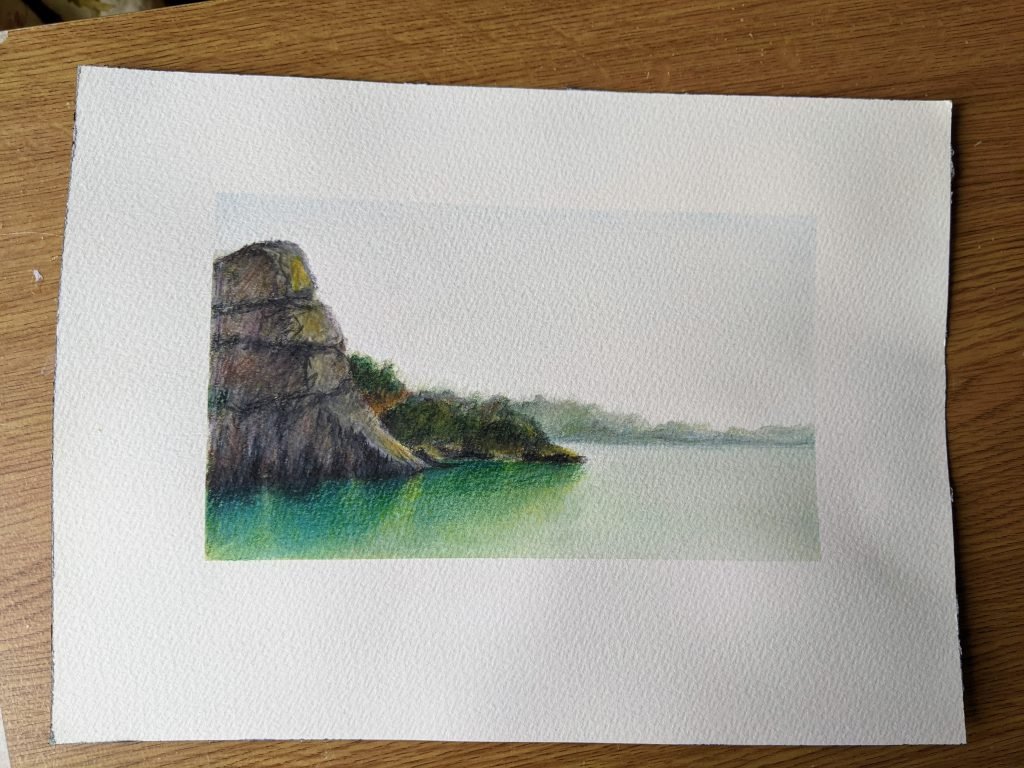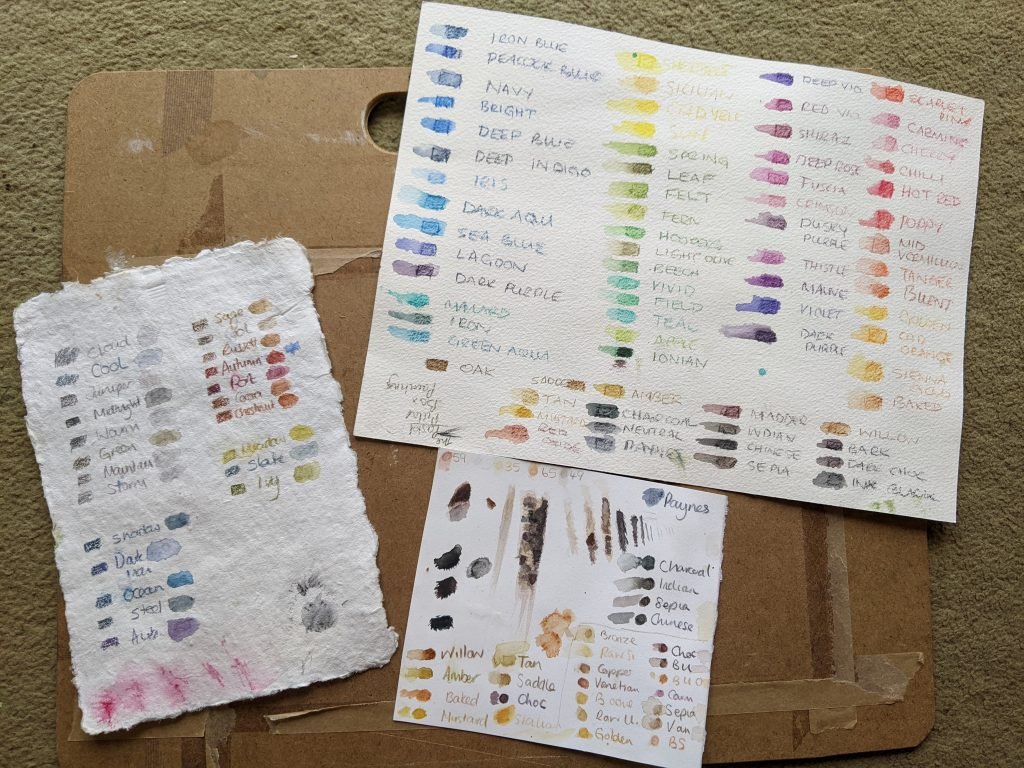Learning how to use watercolour pencils is a lovely way to explore art; I’ve loved them since I was a child, and I have to admit that I may have a pencil buying problem!
Watercolour pencils are versatile, transportable, and come in a wide range of colours and brands. You can keep things simple and just use them on therapeutic colouring pages, or you can take things further and learn about mixing them and creating your own unique art.
This blog post is the first in a series I’ll be putting together, and I will include information about the best watercolour pencils on the market, what the best paper to use is; I’ll even throw in some tutorials and free PDF downloads for you.
By the time I’ve finished you’ll be creating your own paintings for the kitchen, lounge, and all your friends and family too!
But for today, let’s start with a simple introduction.
Which Paper is Best for Watercolour Pencils?
The simple answer is ‘the best that you can afford’ but I will take some time to show you how you can get good results on affordable paper. The reality is, it depends on the work, your style, and your pocket. When you are learning you may not want to spend money on expensive paper, but I hope that if you come along with me I’ll help you make the best decisions.
Essentially, watercolour paper is readily available at places like WH Smiths and Amazon, and I can show you how to stretch the paper to decrease the chance of it buckling. I will supply a list of my preferred suppliers too, but for experimentation in the early stages, choose progress over perfection.
How to Use Watercolour Pencils – Dry then Wet Technique
I think one of the key techniques for using watercolour pencils is to use them dry, then blend with a brush. It seems simple, and it can be, but as I started writing this article I thought about how important it is to also have knowledge of how to paint with watercolours to apply to your pencil projects.
Let me explain.
When I use watercolour paint, I tend to use the layering method. This enables you to create depth and tone to your work, and fortunately you can do this with watercolour pencils too. Having said that, this particular article is aimed at those who are learning, so I will keep to the basics here, then add more in future blog posts. At the end of the day, practice is key to improving any skill.
Onwards to an example.
This is a watercolour pencil seascape that I painted a while ago. I love it.
I love the calm water, the simple sky, and the impressionistic rocks in the foreground. It is created with several different techniques. A final flourish with my Lightfast oil pencils picks out the highlights.

Painting something like this with watercolour pencils is a great way to practice your skills. Patience is required, as is a gentle touch. This is key to growth as an artist, and because of this I’m going to make a tutorial to demonstrate.
It will land on You Tube and here soon, but in the meantime let’s talk about some basics.
How to Make a Colour Chart with Watercolour Pencils
Watercolour pencils vary in terms of their pigmentation, so it’s important to make swatch cards of your colours. Initially, you can just wash out each pencil on its own but you may wish to try mixing to make new colours too. I’ve dipped into how to do this in the video at the bottom of the page, but there will be more detailed demonstrations coming soon!

You'll notice in these swatch pages there are different types of paper. This is because different papers have different absorbency and surface texture. Featured here are a smooth, a handmade rag paper, and a widely available Daler Rowney paper. In addition, there are three different types of pencils used - Graphitint, Inktense, and Fine Art Watercolour pencils.
Making a Watercolour Pencil Palette on Paper
As you can see in the photo above, I have scribbled on the paper then wetted the pencil with a brush to activate the colour. You can take this a step further by laying down more pigment before adding more water to make a puddle of colour. Then, you can paint with it.
The results you get will vary depending of the type of watercolour paper you choose, but that’s part of the fun!
Remember, the most important thing is to experiment and enjoy it. That’s how you’ll learn and improve.
Colour Mixing with Watercolour Pencils
I will create a video and separate blog post about colour mixing. It is a complex subject if we get into cool and dark colours, so I’d rather do it justice independently. One step at a time, my friends!
Using Water-soluble Pencils Dry
This one is self explanatory, but I will delve into dry pencil work in another post. I have included a little on this in the video at the end of the page though.
How to Use Watercolour Pencils – Layering Technique – Dry, Wet, Dry
This is my favoured approach (as referred to earlier), and it allows you to create detail and definition in the final layers. When using this method, good paper is your friend. If the paper has a good ‘tooth’ it will allow you to add more layers.
Here is an example of one of my recent pet portraits. I have been able to use watercolour painting techniques whilst using my pencils. I used masking fluid, layering, and different brushes to achieve most of the painting, and then I’ve gone in with my Inktense pencils to bring Cory to life.
Should I Dip Watercolour Pencils in Water?
Don’t dip them in water. It will cause damage long term. With that said, I have been known to use a miniature brush to dab the end on occasion. I’ll show you this, but do not dip!
What are the Best Watercolour Pencils?
Now there is a difference in quality and pigment with this art medium, as with any, but that doesn’t mean you must buy the most expensive to get good results. I own some pencils from my childhood, artist’s quality pencils, and some from WH Smith. I use all of them.
This is partly because there are some colours in the cheaper sets that I adore. Technique and the right surface can help you create wonderful pieces of art without shelling out hundreds of pounds.
I’m beginning to sound like a broken record here, but I will come back to this with specific projects and paper samples in later posts.
Bottom line… enjoy learning, and allow yourself to make mistakes. The best products in the world won’t make creating art a pleasure for you – only you can do that!
Beginners Watercolour Pencil Ideas
I’ve been out in the garden this morning, and I took a couple of videos and many photos. It seems like using those for reference might be a good idea. I also have many landscape painting ideas as well as example of art painted using watercolour pencils so I’ll share those too.
Whether you want to create a snow painting, still life, or master the art of miniatures, there will be something for you to try.
Watercolour Pencil Tutorial Video
The video to support this article is next. Watch it to learn more about watercolour pencils, as well as some examples of my own paintings using them. I’ll be doing some videos to show you how to do these too.
I almost forgot! You can visit my Patreon page here. It’s a great way to support artists, and it allows me to add the personal touch. I will be posting free and paid tutorials there, and I’d love to get to know you.
You can also find me on Social Media and all of my posts are added to Pinterest. This one will be on the board called ‘how to use watercolour pencils’.
